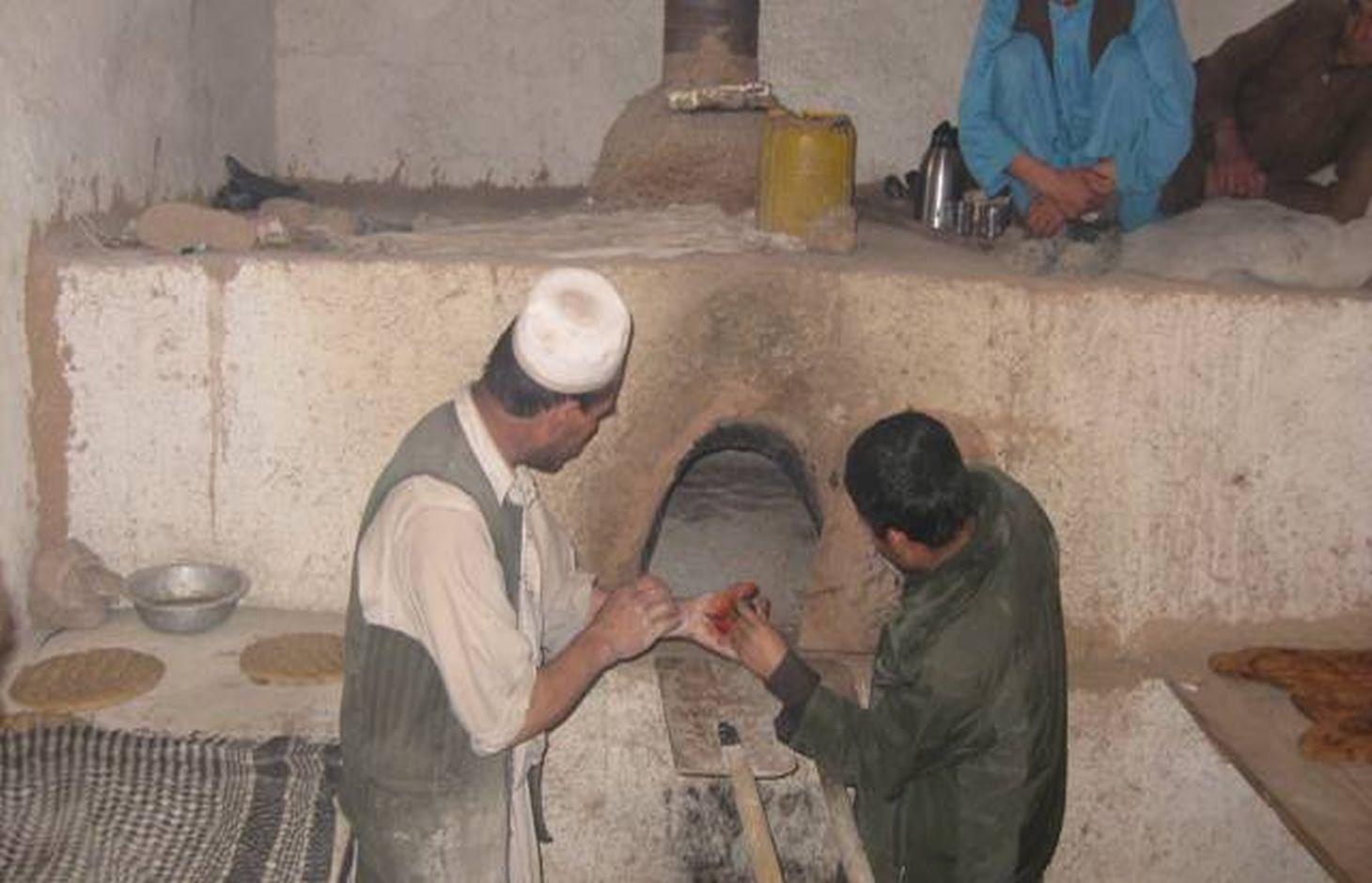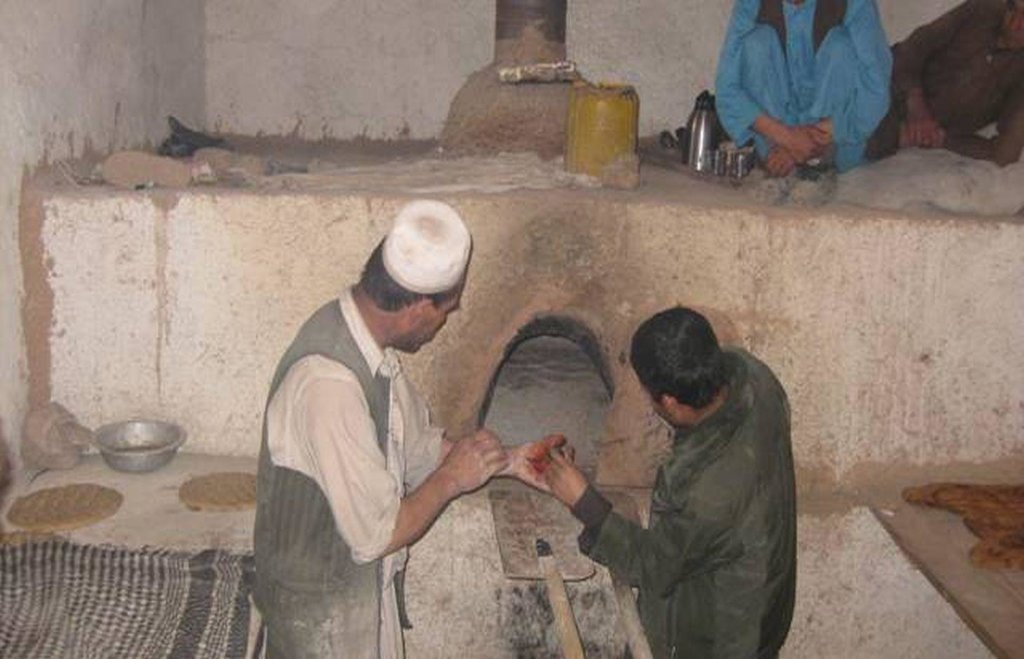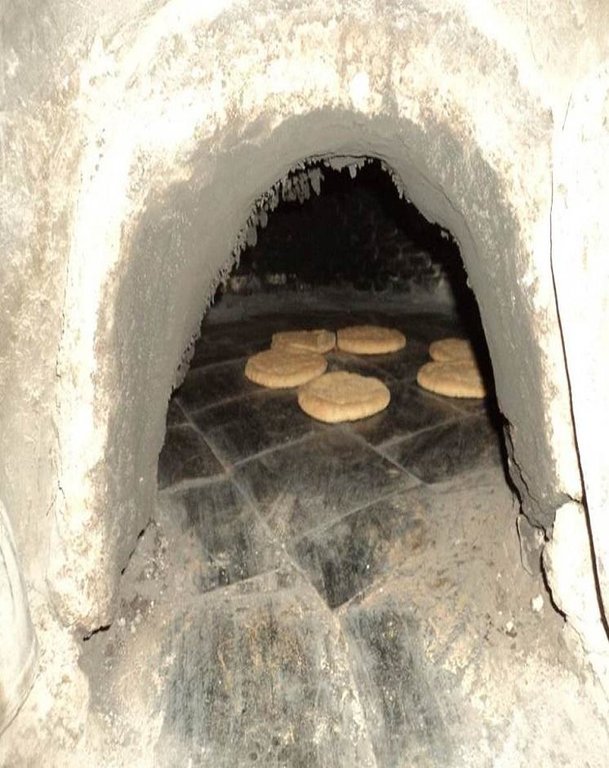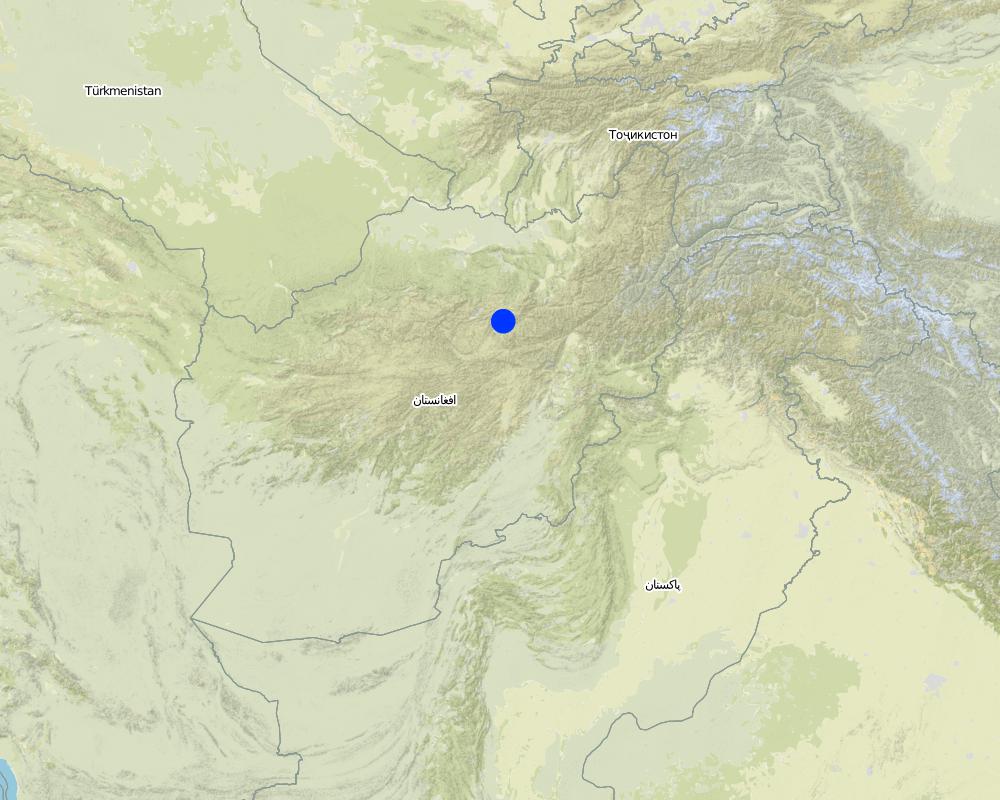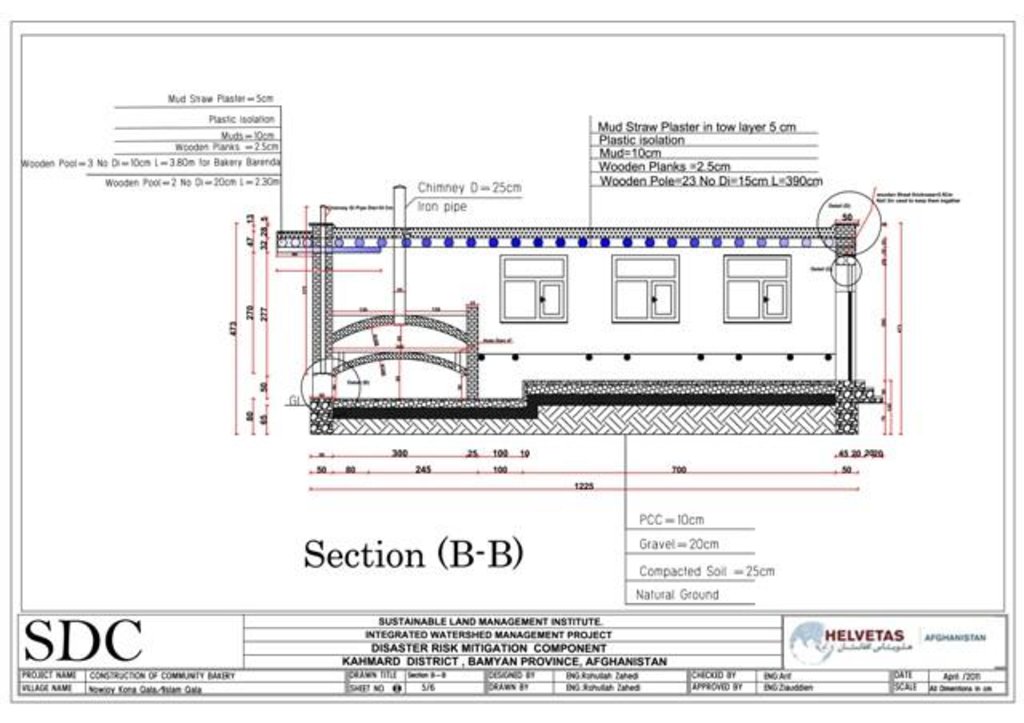Community bakery [Afganistán]
- Creación:
- Actualización:
- Compilador: Aqila Haidery
- Editor: –
- Revisores: Deborah Niggli, Joana Eichenberger
Dash Nanboe (Dari)
technologies_1718 - Afganistán
Visualizar secciones
Expandir todo Colapsar todos1. Información general
1.2 Detalles de contacto de las personas de referencia e instituciones involucradas en la evaluación y la documentación de la Tecnología
Especialista MST:
Homayoun Ashraf
HELVETAS Swiss Intercooperation
Afganistán
Especialista MST:
Ahmad Ali Sediqi
HELVETAS Swiss Intercooperation
Afganistán
Nombre de la(s) institución(es) que facilitaron la documentación/ evaluación de la Tecnología (si fuera relevante)
HELVETAS (Swiss Intercooperation)1.3 Condiciones referidas al uso de datos documentados mediante WOCAT
El compilador y la/s persona(s) de referencia claves aceptan las condiciones acerca del uso de los datos documentados mediante WOCAT:
Sí
1.4 Declaración de la sostenibilidad de la Tecnología descrita
¿La Tecnología aquí descrita resulta problemática en relación a la degradación de la tierra, de tal forma que no puede considerársela una tecnología sostenible para el manejo de la tierra?
No
2. Descripción de la Tecnología MST
2.1 Breve descripción de la Tecnología
Definición de la Tecnología:
A sustainable option for bread baking and reducing shrub consumption
2.2 Descripción detallada de la Tecnología
Descripción:
Thirty six community bakeries were constructed in Kahmard from 2009-2012 for reducing shrub consumption. Rural communities normally bake bread at home using tandoors made from clay and fired by shrubs, wood and coal. Bread baking is a demanding task. Men and boys climb mountains to collect shrubs, putting themselves at risk, and women spend 1-2 hours/day for preparing dough, firing the oven and baking bread. Shrub cutting causes upland degradation leading to flash floods in the valleys.
In Saighan, district adjoining Kahmard, a survey showed that one household uses 81 donkey load shrubs annually, and minimum 50 donkey loads are used for baking bread. Kahmard has a similar situation. To address this, HELVETAS Swiss Intercooperation is supporting an integrated watershed management in Kahmard since 2008 with support from the Swiss Re and Swiss Agency for Development and Cooperation (SDC). The approach comprises other technological and organisational measures where structural and vegetative are applied, combined with grazing and shrub cutting control. To complement re-greening efforts, energy efficient community bakeries were promoted.
Households using community bakeries reported a decrease in shrub consumption by 50-80%, which contributes to greener watersheds. The other benefits include more time for women, boys and girls for other preferred activities, like attending school, literacy classes, vocational trainings, embroidery, etc. Families also save money (minimum US$ 10/month) as they have to purchase less shrubs for baking purpose. In Kahmard, one donkey load shrub costs about US$ 6. Bakers, assistant bakers, masons and workers are employed and bakeries serve as a place for social networking. By contributing to greener watersheds, the bakeries help to reduce flash flood risks. In recent months, running the bakeries has become a challenge as the coal mines in Kahmard have been contracted to a Chinese firm. As a consequence, people are not getting coal easily. Due to coal shortages, several bakeries have stopped functioning. People are looking towards the government authorities to solve this issue as soon as possible. Many households have gone back to shrub cutting and a community assets with proven benefits for the people but environment remains underutilized.
The participating community development councils or CDCs allocate land for bakery. One bakery costs about US$ 4640, with 25% community contribution during construction. It takes about 5 weeks for constructing one bakery if there are no obstacles. About US$ 7300/year is spent on operation and maintenance by the people. One baker and 1-2 assistants are employed for daily bakery operations. The dash or oven is prepared from a mixture of clay and sheep hair and fired by coal. About 1-3 bags are required per day. If mosaic tiles are used, about 1 bag per day is used for heating. The factors influencing the success of community bakeries include access to coal, good quality and low price of coal, on time payment and proper management of bakery funds. The clients bring dough from home and pay about US$ 0.042 (2 Afghani) per bread to the baker or about US$ 6.6/month.
Community bakeries were constructed in the Kahmard district in the valley bottoms where the people reside. The land for community bakeries normally belongs to the community, but where suitable common land is not available, individuals have also donated their private lands for the common cause.
Community bakeries are located at an altitude of about 1700-1800 m above mean sea level. The district receives up to 400 mm rainfall in a good year. In the valley bottom, there are crop growing seasons, the main is from March to July. The land users rely mainly on agriculture for their livelihoods as employment opportunities in the district are very few. Kahmard district has a population density of about 30 person/sq. km. About 50% of the rural population in Kahmard falls under poor category, 40% are medium rich and 10% rich.
2.3 Fotografías de la Tecnología
2.5 País/ región/ lugares donde la Tecnología fue aplicada y que se hallan comprendidos por esta evaluación
País:
Afganistán
Región/ Estado/ Provincia:
Bamyan Province
Especifique más el lugar :
Kahmard district
Especifique la difusión de la Tecnología:
- distribuida parejamente sobre un área
Si se desconoce el área precisa, indique el área aproximada cubierta:
- < 0.1 km2 (10 ha)
Comentarios:
Each bakery has an area of about 58 sq. m, and 25 bakeries have been constructed so far in Kahmard district with HELVETAS Swiss Intercooperation support and financial contributions from the Swiss Agency for Development and Cooperation (SDC).
Map
×2.6 Fecha de la implementación
Si no se conoce el año preciso, indique la fecha aproximada:
- hace menos de 10 años (recientemente)
2.7 Introducción de la Tecnología
Especifique cómo se introdujo la Tecnología:
- mediante proyectos/ intervenciones externas
Comentarios (tipo de proyecto, etc.):
The first community bakery in Kahmard district was constructed in 2009 with HELVETAS Swiss Intercooperation support. Since then, 25 bakeries have been constructed as a complementary watershed management technology.
3. Clasificación de la Tecnología MST
3.2 Tipo(s) actuales de uso de la tierra donde se aplica la Tecnología

asentamientos, infraestructura
- Community bakeries

Tierra no productiva
Especifique:
Wastelands, deserts, glaciers, swamps, recreation areas, etc before Technology, settlements, infrastructure networks afterwards.
Comentarios:
Major land use problems (compiler’s opinion): Severe flash floods due to degradation of upland watersheds as a result of overgrazing, shrub uprooting, ploughing and recurring droughts. There is a lack of organizational capacities for sustainable management of land and water resources.
Major land use problems (land users’ perception): Severe flash floods due to watershed degradation resulting in destruction of property and life. Lack of knowledge about disaster risk mitigation. Lack of alternatives to fuel wood, especially for bread baking and house warming.
Future (final) land use (after implementation of SLM Technology): Other: Os: Settlements, infrastructure networks
Constraints of settlement / urban: Some areas are not fully utilized. Some are vulnerable to flash floods.
Number of growing seasons per year: 2
Longest growing period in days: 150, Longest growing period from month to month: March to July, Second longest growing period in days: 90, Second longest growing period from month to month: August to October
3.3 ¿Cambió el uso de tierras debido a la implementación de la Tecnología?

Tierra no productiva
Especifique:
Wastelands, deserts, glaciers, swamps, recreation areas, etc before Technology, settlements, infrastructure networks afterwards.
3.5 Grupo MST al que pertenece la Tecnología
- pastoralismo y manejo de tierras de pastoreo
- cobertura de suelo/ vegetal mejorada
3.6 Medidas MST que componen la Tecnología

medidas estructurales
- S11: Otros
3.7 Principales tipos de degradación del suelo encarados con la Tecnología

erosión de suelos por agua
- Wt: pérdida de capa arable/ erosión de la superficie
- Wg: erosión en cárcavas

degradación biológica
- Bc: reducción de la cobertura vegetal del suelo
Comentarios:
Main causes of degradation: over-exploitation of vegetation for domestic use (extraction of shrubs for fuelwood), overgrazing (Overgrazing by sheep and goats), disturbance of water cycle (infiltration / runoff) (Due to biological degradation), droughts (Recurring droughts slow down vegetation recovery), land tenure (If it was private land, degradation extent would have been much less), governance / institutional (There is no legal and institutional set up for community based natural resource management)
Secondary causes of degradation: deforestation / removal of natural vegetation (incl. forest fires) (Removal of Juniper trees during war period), other natural causes (avalanches, volcanic eruptions, mud flows, highly susceptible natural resources, extreme topography, etc.) specify (Some grazed areas are very steep), population pressure (Due to increasing population, there is increasing pressure on natural resources), poverty / wealth (People depend on livestock. There is lack of off-farm employment opportunities), war and conflicts (During war, traditional NRM systems also collapsed)
3.8 Prevención, reducción o restauración de la degradación del suelo
Especifique la meta de la Tecnología con relación a la degradación de la tierra:
- reducir la degradación del suelo
- restaurar/ rehabilitar tierra severamente degradada
4. Especificaciones técnicas, actividades de implementación, insumos y costos
4.1 Dibujo técnico de la Tecnología
Especificaciones técnicas (relacionadas al dibujo técnico):
A detailed technical drawing (long section) of a community bakery in Kahmard district supported by HELVETAS Swiss Intercoop-eration with the dome shaped oven or dash.
Location: Nowjoy Kona Qala. Kahmard district/Bamyan province
Date: 04/2009
Technical knowledge required for field staff / advisors: moderate (The community bakery was designed by Engineers of HELVETAS Swiss Intercooperation)
Technical knowledge required for land users: high (Construction of dash requires high technical knowledge. There are however some very skilled people in the community who know the art of making dash.)
Main technical functions: improvement of ground cover, increase of infiltration, Reduces people's dependency on shrubs, which are extracted from the upland watersheds
Structural measure: Community Bakery
Height of bunds/banks/others (m): 4.75
Width of bunds/banks/others (m): 7.45
Length of bunds/banks/others (m): 12.5
Construction material (earth): Soil/clay/sand
Construction material (stone): stones for foundation/bricks (sun dried)
Construction material (wood): Poles for roof beams, doors, windows
Construction material (concrete): cement, gypsum
Construction material (other): hair for dash
Autor:
Eng. Rohullah Zahedi, HELVETAS Swiss Intercooperation, Afghanistan
4.2 Información general sobre el cálculo de insumos y costos
otra / moneda nacional (especifique):
Afghani
Si fuera relevante, indique la tasa de cambio de dólares americanos a la moneda local (ej. 1 U$ = 79.9 Reales Brasileros): 1 U$ =:
50,0
Indique el costo promedio del salario de trabajo contratado por día:
5.00
4.3 Actividades de establecimiento
| Actividad | Momento (estación) | |
|---|---|---|
| 1. | Construction of community bakery as per technical design and based on feasibility study | Five months |
4.4 Costos e insumos necesarios para el establecimiento
| Especifique insumo | Unidad | Cantidad | Costos por unidad | Costos totales por insumo | % de los costos cubiertos por los usuarios de las tierras | |
|---|---|---|---|---|---|---|
| Mano de obra | 1,0 | 1223,0 | 1223,0 | 10,0 | ||
| Equipo | Tools | 1,0 | 60,0 | 60,0 | 100,0 | |
| Material de construcción | Sand, soil, cement, gypsum, br | 1,0 | 3356,0 | 3356,0 | 30,0 | |
| Costos totales para establecer la Tecnología | 4639,0 | |||||
| Costos totales para establecer la Tecnología en USD | 92,78 | |||||
Comentarios:
Duration of establishment phase: 1.5 month(s)
4.5 Actividades de establecimiento/ recurrentes
| Actividad | Momento/ frequencia | |
|---|---|---|
| 1. | Bakery operation (Baker and Assistant Baker salaries) | Year round |
| 2. | Roof plastering with clay and straw | Once before winter |
| 3. | Baking bread | Year round |
| 4. | Dash firing and heating | year round |
| 5. | Fire ignition | Year round |
4.6 Costos e insumos necesarios para actividades de mantenimiento/ recurrentes (por año)
| Especifique insumo | Unidad | Cantidad | Costos por unidad | Costos totales por insumo | % de los costos cubiertos por los usuarios de las tierras | |
|---|---|---|---|---|---|---|
| Mano de obra | 1,0 | 3600,0 | 3600,0 | 100,0 | ||
| Material de construcción | Roof plastering mud and straw | 1,0 | 38,5 | 38,5 | 100,0 | |
| Material de construcción | Coal | 1,0 | 3650,0 | 3650,0 | 100,0 | |
| Material de construcción | Tyre | 1,0 | 300,0 | 300,0 | 100,0 | |
| Material de construcción | Dash shovel | 1,0 | 10,0 | 10,0 | 100,0 | |
| Indique los costos totales para mantenecer la Tecnología | 7598,5 | |||||
| Costos totales para mantener la Tecnología en USD | 151,97 | |||||
Comentarios:
Machinery/ tools: Sand, Soil, cement, gypsum, bricks, stones, gravel, straw, plastic, clay, hair, wooden door, timber for beams, glass, paint, gutter pipes. Ventilation pipes
The costs in 2.6.1. relate to the construction, operation and maintenance of one community bakery. The estimates are based on the Bills of Quantity prepared in 2009.
4.7 Factores más determinantes que afectan los costos:
Describa los factores más determinantes que afectan los costos:
Most of the expenses for construction work is on equipment and materials like shovels, pick axe, wheel barrow, wooden doors, timber beams, window, concrete bricks, and sun dried bricks. In terms of recurrent costs, most spending is on coal and on the salaries of the baker and assistant bakers.
5. Entorno natural y humano
5.1 Clima
Lluvia anual
- < 250 mm
- 251-500 mm
- 501-750 mm
- 751-1,000 mm
- 1,001-1,500 mm
- 1,501-2,000 mm
- 2,001-3,000 mm
- 3,001-4,000 mm
- > 4,000 mm
Zona agroclimática
- semi-árida
Thermal climate class: temperate. The minimum temperature in Kahmard district can be up to -70°C.
5.2 Topografía
Pendientes en promedio:
- plana (0-2 %)
- ligera (3-5%)
- moderada (6-10%)
- ondulada (11-15%)
- accidentada (16-30%)
- empinada (31-60%)
- muy empinada (>60%)
Formaciones telúricas:
- meseta/ planicies
- cordilleras
- laderas montañosas
- laderas de cerro
- pies de monte
- fondo del valle
Zona altitudinal:
- 0-100 m s.n.m.
- 101-500 m s.n.m.
- 501-1,000 m s.n.m
- 1,001-1,500 m s.n.m
- 1,501-2,000 m s.n.m
- 2,001-2,500 m s.n.m
- 2,501-3,000 m s.n.m
- 3,001-4,000 m s.n.m
- > 4,000 m s.n.m
5.3 Suelos
Profundidad promedio del suelo:
- muy superficial (0-20 cm)
- superficial (21-50 cm)
- moderadamente profunda (51-80 cm)
- profunda (81-120 cm)
- muy profunda (>120 cm)
Textura del suelo (capa arable):
- mediana (limosa)
Textura del suelo (> 20 cm debajo de la superficie):
- mediana (limosa)
Materia orgánica de capa arable:
- baja (<1%)
5.4 Disponibilidad y calidad de agua
Agua subterránea:
5-50 m
Disponibilidad de aguas superficiales:
bueno
Calidad de agua (sin tratar):
agua potable de buena calidad
Comentarios y especificaciones adicionales sobre calidad y cantidad de agua:
When the water is fetched from wells or natural springs the water is good drinking water, otherwise it is poor drinking water (surface water, must be treated before consumption)
5.5 Biodiversidad
Diversidad de especies:
- baja
5.6 Las características de los usuarios de la tierra que aplican la Tecnología
Ingresos no agrarios:
- 10-50% de todo el ingreso
Nivel relativo de riqueza:
- pobre
- promedio
Individuos o grupos:
- grupos/ comunal
Género:
- hombres
Indique otras características relevantes de los usuarios de las tierras:
Land users applying the Technology are mainly common / average land users
Difference in the involvement of women and men: Men are mostly involved in the construction and operation of the bakeries. However, in some areas women and girls bring pasta to the bakery for bread baking. Women's support for community bakeries is strong as they benefit directly .
Population density: 10-50 persons/km2
Annual population growth: 2% - 3%
10% of the land users are very rich.
40% of the land users are average wealthy.
50% of the land users are poor.
Off-farm income specification: Due to small land holding size, there is not enough income from the farmlands to support large families. Therefore, people rely on seasonal work opportunities either within the district or their communities or migrate to Afghan cities or neighboring countries for work. Some people work in coal mines which are present in the district.
5.7 Área promedio de la tierra usada por usuarios de tierra que aplican la Tecnología
- < 0.5 ha
- 0.5-1 ha
- 1-2 ha
- 2-5 ha
- 5-15 ha
- 15-50 ha
- 50-100 ha
- 100-500 ha
- 500-1,000 ha
- 1,000-10,000 ha
- > 10,000 ha
¿Esto se considera de pequeña, mediana o gran escala (refiriéndose al contexto local)?
- escala mediana
5.8 Tenencia de tierra, uso de tierra y derechos de uso de agua
Tenencia de tierra:
- comunitaria/ aldea
- individual, con título
Derechos de uso de tierra:
- comunitarios (organizado)
Derechos de uso de agua:
- comunitarios (organizado)
Comentarios:
Mostly, the land used for community bakeries belongs to the community. In case suitable land is not available, the community development council members and village elders motivate individuals to spare their land for the common cause.
5.9 Acceso a servicios e infraestructura
salud:
- pobre
- moderado
- bueno
educación:
- pobre
- moderado
- bueno
asistencia técnica:
- pobre
- moderado
- bueno
empleo (ej. fuera de la granja):
- pobre
- moderado
- bueno
mercados:
- pobre
- moderado
- bueno
energía:
- pobre
- moderado
- bueno
caminos y transporte:
- pobre
- moderado
- bueno
agua potable y saneamiento:
- pobre
- moderado
- bueno
servicios financieros:
- pobre
- moderado
- bueno
6. Impactos y comentarios para concluir
6.1 Impactos in situ demostrados por la Tecnología
Impactos socioeconómicos
Producción
producción de madera
Comentarios/ especifique:
This is due to less shrub extraction in the watersheds
generación de energía
Ingreso y costos
diversidad de fuentes de ingreso
Comentarios/ especifique:
Some women have more time and can take part in off-farm income generation activities. e.g. embroidery.
Otros impactos socioeconómicos
Air pollution
Comentarios/ especifique:
Due to burning of coal.
Loss of income for shrub collectors
Comentarios/ especifique:
Less demand for shrubs for fire wood.
Impactos socioculturales
seguridad alimentaria/ autosuficiencia
Comentarios/ especifique:
Due to more savings, people can buy more food and reduce their food gaps.
situación de salud
Comentarios/ especifique:
Less exposure to smoke and heat.
oportunidades culturales
Comentarios/ especifique:
More opportunities for social networking for men and women.
oportunidades recreativas
Comentarios/ especifique:
Especially for women as they have more time.
instituciones comunitarias
Comentarios/ especifique:
People cooperate with each other for running the bakeries. There are less conflicts over bread baking within the households. There is also more social networking as people meet more often at the bakeries when they bring dough.
MST/ conocimiento de la degradación del suelo
Comentarios/ especifique:
People understand well the linkage between community bakeries, watershed management and flash flood risk mitigation.
mitigación de conflicto
Comentarios/ especifique:
Especially members of a family over bread baking or shrub collection.
Impactos ecológicos
Ciclo de agua/ escurrimiento de sedimento
escurrimiento superficial
Comentarios/ especifique:
Due to better vegetation cover in the watersheds.
Suelo
cubierta del suelo
Comentarios/ especifique:
Due to more shrubs in the watersheds.
Biodiversidad: vegetación, animales
biomasa/ sobre suelo C
Comentarios/ especifique:
Due to increased shrub cover.
Otros impactos ecológicos
energy generation (eg hydro, bio)
Comentarios/ especifique:
Use of coal which is plenty available in the district due to presence of coal mines.
6.2 Impactos fuera del sitio demostrados por la Tecnología
inundaciones río abajo
Comentarios/ especifique:
Due to more vegetation cover and increased infiltration.
daños a infraestructura pública / privada
Comentarios/ especifique:
Due to reduced flash floods,
6.3 Exposición y sensibilidad de la Tecnología al cambio climático gradual y a extremos relacionados al clima/ desastres (desde la percepción de los usuarios de tierras)
Cambio climático gradual
Cambio climático gradual
| Estación | Incremento o reducción | ¿Cómo es que la tecnología soporta esto? | |
|---|---|---|---|
| temperatura anual | incrementó | bien |
Extremos (desastres) relacionados al clima
Desastres climatológicos:
| ¿Cómo es que la tecnología soporta esto? | |
|---|---|
| tormenta de lluvia local | no muy bien |
| tormenta de viento | bien |
Desastres climatológicos
| ¿Cómo es que la tecnología soporta esto? | |
|---|---|
| sequía | bien |
Desastres hidrológicos
| ¿Cómo es que la tecnología soporta esto? | |
|---|---|
| inundación general (río) | no muy bien |
Otras consecuencias relacionadas al clima
Otras consecuencias relacionadas al clima
| ¿Cómo es que la tecnología soporta esto? | |
|---|---|
| periodo reducido de crecimiento | bien |
Comentarios:
If the weather gets too cold, more coal may be required for dash heating. There can be damages due to heavy rainfall but the bakeries can still operate. Therefore, it is not a major issue. Even without climatic extremes, the bakeries can be damaged due to flash floods.
Modifications possible: Bakeries should not be constructed near the flood ways.
6.4 Análisis costo-beneficio
¿Cómo se comparan los beneficios con los costos de establecimiento (desde la perspectiva de los usuarios de tierra)?
Ingresos a corto plazo:
positivo
Ingresos a largo plazo:
muy positivo
¿Cómo se comparan los beneficios con los costos de mantenimiento/ recurrentes (desde la perspectiva de los usuarios de tierra)?
Ingresos a corto plazo:
positivo
Ingresos a largo plazo:
muy positivo
Comentarios:
One does not have to wait for getting direct benefits from a community bakery. The day one starts using a bakery, shrub consumption by a family will start to reduce. The benefits should also take into account improvements in the quality of people's lives, especially of the women and children.
6.5 Adopción de la Tecnología
- > 50%
De todos quienes adoptaron la Tecnología, ¿cuántos lo hicieron espontáneamente, por ej. sin recibir nada de incentivos/ materiales:
- 0-10%
Comentarios:
100% of land user families have adopted the Technology with external material support
This is mainly because of the high investment during the investment phase. But there is one CDC in Kahmard which applied this technology by their own. People in Qaghor community bakery (initially supported by HELVETAS Swiss Intercooperation) changed the traditional oven/dash into a mosaic one without any external support.
There is a little trend towards spontaneous adoption of the Technology
Comments on adoption trend: One CDC adopted this technology without any external help.
6.7 Fuerzas/ ventajas/ oportunidades de la Tecnología
| Fuerzas/ ventajas/ oportunidades desde la perspectiva del usuario de la tierra |
|---|
| If the dash is made of mosaic, there is less coal consumption, bread quality is better and it takes less time to bake |
| Fuerzas/ ventajas/ oportunidades desde la perspectiva del compilador o de otra persona de referencia clave |
|---|
| Reduces shrub consumption and helps in watershed re-greening leading to reduced flash flood risks |
| Better lives and health of women, men and children and cash saving |
| Collective action and community ownership |
| Use of locally resources |
| For the cost of 1 donkey load of shrubs, a family can get baked bread for a whole month |
6.8 Debilidades/ desventajas/ riesgos de la Tecnología y formas de sobreponerse a ellos
| Debilidades/ desventajas/ riesgos desde la perspectiva del usuario de la tierra | ¿Cómo sobreponerse a ellas? |
|---|---|
| Clay oven requires frequent maintenance | Alternatives like use of mosaic tiles could be an option and should be further explored. |
| As it is dark inside the dash, bakers have to use a torch and it also exposes them to heat | Develop better lighting systems. For instance a window opposite dash for more light or the dash could have a gentle slope. |
| 2-3 bags of coal are used per day | The oven could be made more energy-efficient, for instance by improving insulation layering or by using mosaic tiles. |
| Bakeries are used for only bread baking | Options like heating water for which people can collect or a hot bath (hamam) could be integrated. |
| Debilidades/ desventajas/ riesgos desde la perspectiva del compilador o de otra persona de referencia clave | ¿Cómo sobreponerse a ellas? |
|---|---|
| Bakeries run on coal, and due to restrictions on coal mining some of them have stopped running | Government should solve this problem. |
| Minimum 80 families are required for running the bakeries profitably | Develop a model which caters to 10-20 households. Also, action research on different sizes and fuel consumation (coal, wood, gas, etc.). |
| Loss of income for few shrub collectors | Provide opportunities for off or on-farm income generation and cash for work. |
7. Referencias y vínculos
7.1 Métodos/ fuentes de información
7.2 Vínculos a las publicaciones disponibles
Título, autor, año, ISBN:
Our daily bread. Community bakeries: a huge benefit for Afghan families, SDC, 2010
¿Dónde se halla disponible? ¿Costo?
http://www.sdc.admin.ch/en/Home/Documentation/Briefing_Papers/Asia_Brief/online: free access
7.3 Vínculos a la información relevante disponible en línea
Título/ descripción:
Community Bakeries in Afghanistan, HELVETAS Swiss Intercooperation, 2011
URL:
http://www.youtube.com/watch?v=YXU15NfOu-8/free
Vínculos y módulos
Expandir todo Colapsar todosVínculos
No hay vínculos
Módulos
No se hallaron módulos


